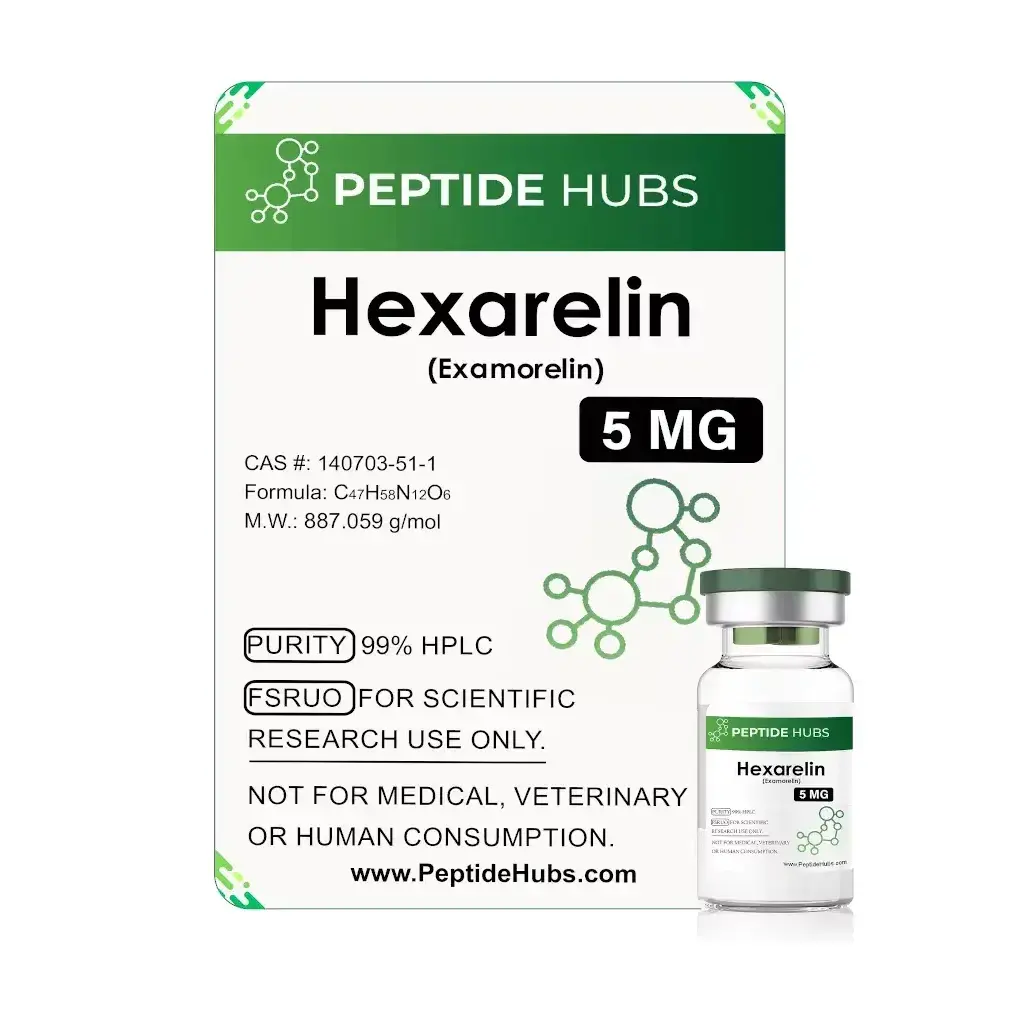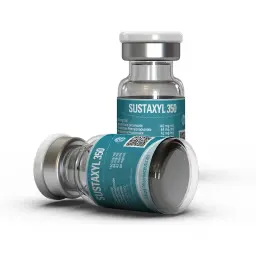


For Subcutaneous Injection
Composition: Examorelin
Dosage: 5 mg/vial
Unit: 2 mL Multidose Vial
Form: Lyophilized Powder
Manufactured by Peptide Hubs
Peptide Hubs Hexarelin 5 mg (also known as examorelin) is a lyophilized research peptide presented in a sterile 2 mL vial for qualified laboratory use. As a member of the growth hormone secretagogue (GHS) family, Hexarelin is examined for its activity at the ghrelin (GHS-R1a) receptor and the resulting pulsatile growth-hormone (GH) behavior observed in experimental models. The 5 mg fill provides a pilot-friendly amount for teams who prefer smaller batches, precise reconstitution, and minimal waste when mapping timing windows or establishing handling SOPs.
Important: The content on this page is for educational discussion in a lawful research setting. This product is not a drug, food, or cosmetic and is not intended to diagnose, treat, cure, or prevent any disease. Purchase and use assume qualified individuals and laboratories operating under applicable regulations and internal SOPs.
Hexarelin is a synthetic hexapeptide that activates the GHS-R1a receptor and is widely referenced in the context of modeling GH pulse characteristics in test systems. Within the GHS family it is often discussed for delivering a pronounced, repeatable signal when handling and timing are carefully standardized. For a foundational overview of the ghrelin/GHS axis in endocrinology (useful when planning pulse intervals, sampling windows, or endpoint selection), see the NIH/NCBI endocrine reference on secretagogues here.
The 5 mg presentation is ideal for pilot studies, method development, and short-horizon protocols where frequent reconstitution is unnecessary. Labs that want to test multiple timing windows (e.g., different administration-to-meal intervals) or compare similar SOPs across several small cohorts can do so efficiently with 5 mg vials. Once your team finalizes a timing framework and data-capture routine, you can scale to larger fills in future runs if desired.
As with all GHS protocols, consistency is the key to interpretability. Establish a run-in baseline to stabilize confounders, then implement the intervention with standardized timing relative to meals, sleep, and training stimulus. Lock in macronutrient distribution and hydration rules for the duration of the study; variability in these areas can blur GH-related outcomes. Document lot numbers, reconstitution solvent/volume, concentration, aliquot size, administration timestamps, and any deviations from SOPs.
Hexarelin is frequently chosen for its robust, repeatable signaling. That reliability makes it a strong candidate in comparison matrices where each arm isolates a single mechanism. Rather than stacking compounds in one arm, many teams run separate arms to preserve data clarity—especially when the other candidates target different biological pathways (dermal/cosmetic, CNS-adjacent, metabolic, or HPG-axis modulation).
Timing: Fix administration windows relative to meals and training. GH-related outcomes are sensitive to nutrition and circadian factors.
Confounders: Stabilize sleep, calories, macronutrient composition, hydration, stimulant intake, and training load. If appetite or satiety cues shift, record them and correlate with weight or tape-measure proxies.
Records: Maintain a checklist for each session—vial ID, reconstitution date and volume, concentration, aliquot size, syringe volume, exact timestamp, temperature at administration, and any deviations. Meticulous logs help explain outliers and support reproducibility.
Peptide Hubs emphasizes batch uniformity, clear labeling, and protective packaging suitable for transit within the USA. Our catalog layout makes protocol planning straightforward, allowing you to select separate, mechanism-specific arms instead of stacking. Whether you are mapping GH pulse characteristics or building cross-axis comparisons, Hexarelin 5 mg slots neatly into a rigorous, audit-friendly workflow with discreet, fast delivery.
If your lab values signal reliability, small-batch efficiency, and SOP-driven consistency, Hexarelin (examorelin) at 5 mg is a practical fit. It supports granular titration, simplifies micro-measurement math, and reduces waste during pilot phases. When your handling steps and timing rules are dialed in, Hexarelin's robust profile makes it a strong cornerstone for GH-pathway research and comparative study designs that demand clarity.
Regulatory Notice: Not for human consumption. For lawful laboratory research by qualified individuals only.
Hexarelin is a ghrelin receptor agonist examined for promoting pulsatile GH behavior in experimental models, supporting studies on timing, recovery, and body-composition proxies.
The 5 mg fill is pilot-friendly, reduces waste, and simplifies precise reconstitution for micro-dosing. It's ideal for short-horizon studies and method development.
Keep lyophilized vials cool, dry, and light-protected. Reconstitute with bacteriostatic water under sterile technique, refrigerate after reconstitution, and avoid freeze–thaw cycles per your SOP.
For clean data, run different mechanisms in separate arms. Compare GH-pathway results against distinct programs like Gonadorelin 10 mg or Semaglutide 5 mg, rather than stacking in a single arm.
No. It is a research-grade peptide not intended to diagnose, treat, cure, or prevent any disease. Use is limited to lawful laboratory research by qualified individuals.
Please log in to write Hexarelin 5 mg review.

For Intramuscular Injection
Composition:
- Testosterone Propionate 42 mg
- Testosterone Phenylropionate 84 mg
- Testosterone Isocaproate 84 mg
- Testosterone Decanoate 140 mg
Mixed Dosage: 350 mg/1 mL
Unit: 10 mL Multidose Vial
Manufactured by Kalpa Pharmaceuticals